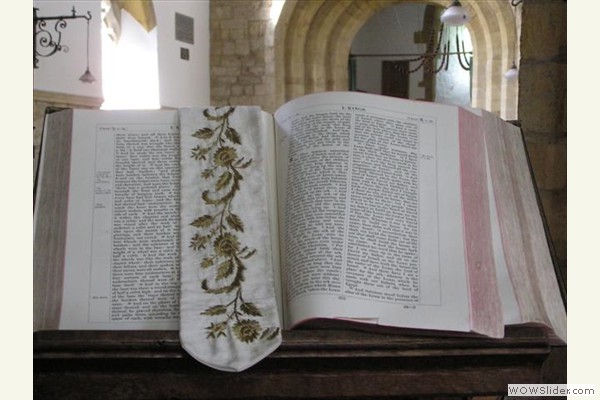
HAYDOCK CATHOLIC BIBLE COMMENTARY ON THE OLD TESTAMENT
EXODUS 27
CHAPTER XXVII.
Ver. 1. Altar, of holocausts, in the open air, before the tabernacle. T. --- Four square, or five cubits in length and breadth, and three in height, which the Rabbins measure from the grate, (v. 5,) or middle of the altar's height. So high the altar was sunk in the earth, (C.) or was built of unhewn stone, on which the wood of the altar rested, being secured by plates of brass above, from the heat of the fire. It was hollow within, and had neither top nor bottom fixed to it. M.
Ver. 2. It. The altar, wood. The horns were for ornament, and were made of brass. Upon them also they might hang the grate, and instruments for sacrifice. C. --- Some of the pagan altars consisted of the horns of animals, (Ovid) and were designed to shew what a number of victims had been offered in their temples. Their gods had frequently horns on their heads. Spencer Rit. iii. 4.
Ver. 3. Pans, &c. The Sept. have, "a crown or border, for the altar, and its covering, and its cups, and flesh-hooks, and fire-place, or pan." Heb. also has five terms; which Calmet renders: 1. a small kettle to receive the ashes under the grate; 2. fire-shovels; 3. bowls to receive blood (mozrokoth, which term the Vulg. does not perhaps notice); 4. flesh-hooks; 5. chafing-dishes. The Protestant version has also the basins or broad cups, phialas, of the Sept. H.
Ver. 5. Midst. Hanging down half way. On this, the wood designed to consume the victim, was placed. The Sept. and Vulg. refer which to the rings, and the present Heb. refers to the grate, or net. But it seems to be inaccurate. The rings were fixed about the middle of the altar's height, to the same holes, through which the bars intended for its removal were put. The altar stood upon feet, which took up half the height, and let in air below the grate, to fan the fire, and to prevent the brass from melting. All the altars described in the table of Isis, are of this nature. C. --- The Sept. do not distinguish the grate from the hearth, or little altar, (arula) as they use the word hearth, escharaboth, (v. 4. and 5,) and place it about the middle of the altar, or where the feet supported the box or frame of the altar, which was almost a yard high. The hearth may therefore denote the bottom of the frame, where the grate was suspended by four rings.
Ver. 9. Court. This inclosed the tabernacle, and the altar of holocausts, being 50 yards long and 25 broad. At the bottom, or western end, there were ten pillars, and on the north and south 20, ornamented in the same manner, and supporting curtains of cotton. But on the eastern side, 10 yards were left, with four pillars in the middle, for an entrance, supporting a richer veil, and on either side three pillars of brass, adorned with circles of silver, as all the rest were. H.
Ver. 10. Engraving. Heb. and Chal. "circles," adorning the chaptrels, (M. v. 17,) or rather the body of the pillars. The chaptrels were covered with plates of silver.
Ver. 19. Tabernacle, with respect to this court; for surely the utensils prescribed in the former chapter, were to be of gold. The Sept. do not mention the tabernacle. C.
Ver. 20. Pestle. That it may be as free from dregs as possible; quasi luxurians defluxerit. Colum. xii. 20. The Heb. and Sept. are silent about the pestle. The olives must, however, be a little bruised, before they will yield their oil. H. --- Always: four of the seven lamps were extinguished every morning. Josep. iii. 9. 1 K. iii. 3. Hecateus (ap. Eus. præp. ix. 4,) assures us, that a light was kept always burning in the tabernacle. The temple of Hercules, at the Straits, its priests and ceremonies, bore some resemblance with the tabernacle and usages prescribed by Moses. It was probably erected by the Phenicians. C. --- "The wood seemed to be incorruptible. Women and swine are kept at a distance. White linen covers the priests at the altar; that which adorns their head is most beautiful, and brought from Pelusium. Et Pelusiaco præfulget stamine vertex. They offer incense in long ungirded robes, but the vestment in which they sacrifice, is distinguished with a Latus clavus, or with broad studs of purple, (like the Roman senators.) They go barefoot, their heads shaved, and they observe continence, castumque cubile. They keep a perpetual fire burning on the altars. But no images or statues of the gods have filled the place with majesty and sacred fear."
Sed nulla effigies, simulacraque nota Deorum,
Majestate locum & sacro implevere timore. Sil. Italic. iii.
Ver. 21. Aaron. Here God declares that the sons of Aaron are chosen by him to perform this office. They were not anointed priests till C. xxix. H. --- Light. Thus God admonishes us to let our good works always shine before men. Bede Taber. iii. 1.
Copyright ©1999-2023 Wildfire Fellowship, Inc all rights reserved

 Keep Site Running
Keep Site Running